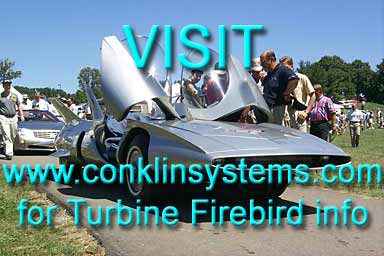
 |
America's First Turbine Car |
![]()
| The April 1954 issue of Motor Life magazine carried
two different Firebird articles, both recreated here.
This one focused on the car and it's development,
the other
was a short piece written by driver Mauri Rose
describing the actual experience of driving the Firebird
I. Though there are a couple statements that we know now to be incorrect, this is still a great piece and provides yet another interesting angle: how the Firebird was perceived by the 1950's auto-enthusiast. |
 |
| "It would . . . be disastrous if in common
with the fate of several other brilliant British
technical achievements, we should discover that the
purely commercial application of the turbine car found
its roots in other lands." - Christopher
Jennings in THE MOTOR (London), March 15, after the
R.A.C. test of the Rover J.E.T., the world's first gas
turbine-powered automobile. "When the turbine car is first put on the road it will be rather expensive and in the high-performance, luxury car class . . . accelerated progress in America makes it extremely likely that the Americans will be the first to put a gas turbine car on the road."-F. R. Bell, turbine engineer, the Rover Company Ltd., in THE AUTOCAR (London), Nov. 21, 1952. "We built the Firebird to help us explore commercial possibilities of the gas turbine . . . we are trying to determine whether the turbine can be harnessed to give efficient and economical performance in the low and normal automotive driving ranges." - Harlow H. Curtice, president, General Motors, Jan. 13, 1954. |
 |
 |
GENERAL MOTORS new Firebird is not just another one
of those Detroit dream cars that make a brief and more or
less brave appearance on the public scene and then are
retired to limbo. The Firebird is America's first gas
turbine car, and the quotations (left) give a fair
indication of the enormous potential significance of that
fact alone. But the Firebird is even more than that. Mauri Rose, three-time Indianapolis winner, was given the job of chauffeuring the Firebird because with its ready-to-blast weight-to-power ratio of 7.5 to one, the reflexes and skills of a virtuoso are needed to control it. Its power plant is just one of its revolutionary features. Another is its aircraft-derived body. More are its all-around independent suspension, its greatly reduced unsprung weight and its radically new brake treatment. The Firebird represents one of the biggest departures from conventional automobile design ever attempted anywhere. This car is no promotional novelty, no gimmick. Its every square inch is daringly and rationally designed. Of,course it is not "the" car of the future - no single machine of today is - but it is along the lines of the Firebird that both racing and passenger cars are likely to develop. |
By this time you know that a gas turbine is essentially a jet engine exhausting against a turbine rotor, transforming the jet's thrust into rotary motion. The idea is an ancient one but its development consistently has been limited by the materials available: bearings, heat-resistant alloys, and so on. The last war, which demonstrated very early the value of jet aircraft, caused the resources of many nations to be put behind the development of jet engines and the materials on which their progress depended. That progress was prompt and continuous and is still rushing forward today. Although gas turbines were used as stationary power plants in Europe for decades before the war, their only application in vehicles was to drive the generators of a few turbo-electric locomotives of the Swiss National Railways. But by the end of the war, many engineers on both sides of the Atlantic were thinking in earnest about the latent potentialities of the gas-turbine automobile idea. The first American to analyze the subject exhaustively before the Society of Automotive Engineers was William A. Turunen. gas turbine expert of G.M.'s Research Laboratories.
| That was in June of 1949. In England in March of 1950, the Rover Company revealed the world's first GT automobile. Little has been heard of it since. In April of the same year the Boeing Airplane Company announced its successful GT conversion of a ten-ton Kenworth truck and a 24-foot Navy personnel boat. Then the Navy contracted for all of Boeing's GT output "for powering minesweeper generators" and the Boeing GT passed from public view. In October, 1951, a feature of the Paris Salon was a Laffly GT-powered prototype bus chassis. No more was heard of it. A year later, at the same show, the world's second GT powered automobile, the Socema-Gregoire, was exhibited and it, too, seems to have retired to at least temporary oblivion. |  Engine and power train are the current ultimate in compactness and simplicity, contain amazingly few moving parts. At present time, high fuel consumption is the major fault of all gas turbines, but this factor is being improved. The Firebird burns inexpensive kerosene fuel for its power. |
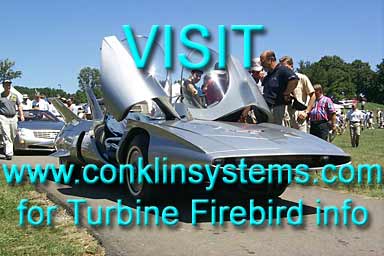 Chief Designer Harley Earl talks over test with Driver Rose. Air inlet midway between nose and front wheel is one of two which provide cockpit ventilation for the driver. |
This kind of short-lived operation apparently was not what GM had in mind. Although they reputedly had small automotive GT engines in production no later than 1950, they were not interested in just another car powered by just another gas turbine. They bided their time, gave the project long and intensive research, and now have come up with a GT car that is likely to set a standard for advanced engineering that the world would do well to follow. |
| THE ENGINE perfected by Turunen for the Firebird, the Whirlfire Turbo-Power GT-302, is the essence of simplicity and compactness, as the diagram suggests. Although it produces 375 bhp it weighs only 775 pounds, including drive train, the entire package being just 26 inches high, 32 inches wide, and 63 inches long. Its weight-to-power ratio is about one-third that of a comparable piston engine assembly. There is no mechanical connection between the GM driving and driven turbines, which have peak speeds of 26,000 and 13,300 rpm respectively. These figures sound high but are actually low for small-GT practice, and it can be inferred that reliability is the object of the low rotational speeds. This engine is designed for rear in- stallation in the Firebird, the final drive unit being an integral part of the power plant. All this is unsprung weight. | 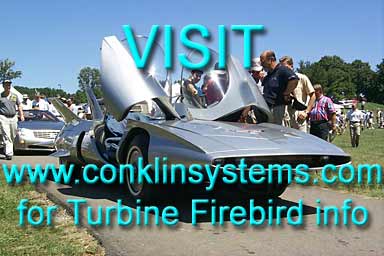 Interesting features of the Firdbird's tail are brake flaps on the trailing edges of the wings and big tailcone, necessitated by the huge volume of air pumped by the GT power unit. |
The engine is divided into two mechanically independent parts, the driving or "gasifier" section and the driven or "power" section, which are connected by a flexible duct. They consist of the following components: Gasifier section:
Power section:
|
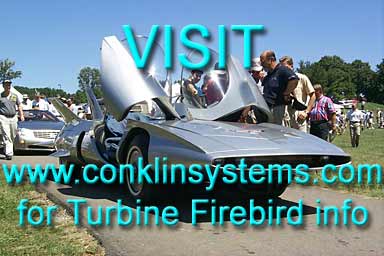 Technicians work on installation of the GM turbine unit it in chassis of the Firebird. Engine fits into a space 63 inches long, 26 inches deep and 32 inches wide |
The gasifier's function is to provide a source of hot compressed gas and it closely resembles a small jet engine. Except for two ball races this unit has one moving part - the shaft on which both curved-vane compressor rotor and gasified turbine wheel are mounted. Air entering the engine is compressed more than 3 ½ times before it enters the two burners into which kerosene is sprayed and where combustion is continuous after a spark ignites the mixture for starting. The hot gas enters the gasifier nozzle ring at 1500 degrees F., is accelerated and directed against the curved blades or buckets attached to the rim of the gasifier turbine wheel. Extraction of power to drive the compressor reduces temperature and pressure of the gas.
The exhaust gas from the gasifier section next passes to the power section, creating a gas coupling between the driving and driven units similar to the coupling between a conventional engine and torque converter transmission. The gasifier section replaces the engine and torque converter pump, the power section replaces the torque converter turbine, transmission, and rear axle gears.
The hot, high pressure gas enters the power section at the power turbine nozzle diaphragm. These nozzles and the gasifier nozzles are actually stationary blades, roughly similar in contour to the turbine blades, against which they direct the gas. Here, more heat and pressure is convert- ed into rotary motion which is transmitted to a compact gearbox by which the driver can select drive range, low range, or reverse. The transmission and the final drive, both contained in the gearbox housing, were developed under the direction of Oliver K. Kelly of the GM Engineering Staff.
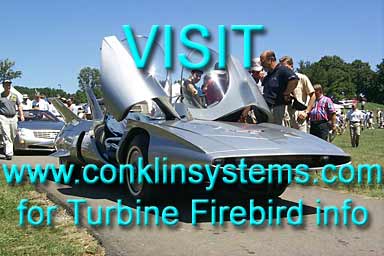 Compressor and two burners are shown on the right side of turbine in this closeup. A virtue of GT engines is their adapability to a wide variety of relatively cheap fuels. |
Since the power section delivers maximum torque to the wheels when the car is standing still, it can be said to have built-in torque converter characteristics, making it unnecessary to shift gears during normal driving. The conventional radiator and cooling systems essential to most piston engines are eliminated and an ignition system is required only for starting. The starter mechanism draws on a 24-volt battery and must crank the gasifier section over at 3,000 rpm before the engine can be fired up. The GT.302 idles at 8,000 rim. A safety device automatically shuts down the engine if one of the two burners fails to fire for any reason. |
Turbine blade failure is a common bugaboo in engines of this type, and Turunen, not content to take advantage of the best alloys currently available, called on Dr. Robert Thomson, head of Research Laboratories' metallurgy department, for the creation of heat resistant alloys specifically suited to the requirements of the Firebird engine. Some of these requirements were:
1. All blades to be cast by lost wax and all nozzles by shell mold processes, rather than being machined from the solid.
2. Gasifier turbine blade-tip speed of 1,000 mph, creating 3,000 pound pull on each half-ounce blade.
3. Alloys resistant to growth or "creep" in spite of the combined effects of this centrifugal force and a red-hot operating temperature of 1,500 degrees F.
4. Each 2.75-inch, two-ounce power turbine blade strong enough to produce six bhp reliably over long periods of time.
With the GT-302 engine, as with every other element of the Firebird, the general order was for stylists, engineers, and researchers not only to draw freely on GM's vast technical backlog of experience, but also to pour their most advanced ideas into the project. In the few cases where recourse to outside agencies might become desirable, it was actively encouraged.
THE FIREBIRD'S Fiberglas shell illustrates this approach. When the project was first conceived Harley J. Earl, GM's vice president in charge of styling staff, chose the jet-fighter aircraft theme. It was obviously appropriate to the new power plant, but that was not all. The Firebird's light, potent chassis was designed to be capable of prodigious speeds (still unannounced) and to lend itself to scientific study of the little understood subject of aerodynamics for land vehicles.
A close approximation of the final body was determined at GM and a scale model shipped to the California Institute of Technology. There, under the direction of Dr. Peter Kyropoulos, extensive wind-tunnel research was carried out on the model and optimum contours were developed for its most critical surfaces. Thus the six square foot area of the vertical tail, the brake flap angles, and the negative angle of attack of the wings were all established through the use of highly specialized facilities not found within the automotive industry.
In view of the painstaking care which has gone into the design of this earth-bound projectile, it will be surprising if the Firebird does not contribute much valuable new data to the study of automotive aerodynamics. Its design suggests that GM is beginning to explore directional stability to an extent not approached before in America and perhaps not in Europe. It is a well-timed step; as passenger car speeds increase aerodynamic effects become increasingly important to designer and consumer.
THE FIREBIRD has other features that indicate its potentialities as a truly experimental car. There are, for example, the special brake flaps mounted on the trailing edges of its wings. These are controlled by switches on the steering wheel and are used to supplement the car's conventional brakes, which are in themselves unusual, in that the brake assemblies are located outboard of the wheel center-lines. The Firebird's wheels are of ribbed light-alloy cast around iron brake drums. A hydraulic wheel cylinder is provided for each brake shoe, and front and rear braking systems are independent but equalized, each having its own master cylinder. The wheel rims are detachable light alloy forgings. The Firebird's front suspension is independent by means of double A-arms and torsion bars, and independent rear suspension is accomplished by a de Dion layout of original GM design. Charles Mccuen, general manager of GM's Research Laboratories, directed the design and construction of the entire chassis by Robert Schilling.
Obviously the gas turbine prime mover is not the only element the Firebird has been built to test. Its full independent suspension, low unsprung weight and improved brakes anticipate the demands that tomorrow's faster passenger cars will make for better tire adhesion, roadability and braking.
If ever there was a laboratory on wheels this is it. Evidently the Firebird will contribute knowledge that can be used in the design of chassis and bodies a very few years from now. The possibilities of its more immediate future are every bit as provocative as its long-range significance. Will, for example, the Firebird set the world's first GT international speed records on the Bonneville Salt? Will Mauri Rose drive it at Indianapolis?
Most important, will the Firebird someday hatch a brood of American turbine-powered passenger cars? That just might happen too.
Questions or comments? Send them to
info2@conklinsystems.com
Conklin Systems 9905 Barnes Hwy
9905 Barnes Hwy Eaton Rapids, MI 48827
Eaton Rapids, MI 48827
Phone (517) 663-6418 Fax (517) 664-5802
Fax (517) 664-5802